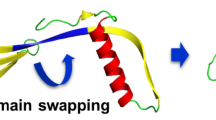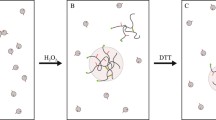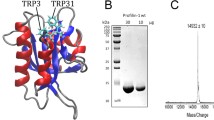Abstract
Wild-type human cystatin C is directly involved in pathological fibrils formation, leading to hemorrhage, dementia and eventually death of people suffering from cerebral amyloid angiopathy. Some studies on cystatin C oligomerization have been already done but some points are still unclear. In order to learn more about this important process, we have investigated thermal and chemical (guanidine hydrochloride-induced) denaturation of human cystatin C. Studies performed using tryptophan fluorescence, calorimetry, circular dichroism and Fourier transform infrared spectroscopy demonstrate that neither chemical nor thermal denaturation of hCC are simple two-state events. One recognized intermediate form was dimeric cystatin C, whose appearance was preceded mainly by changes in the L2 binding loop. The other form occurred only in the chemical denaturation process and was characterized by partially recovered interactions maintaining the protein tertiary structure. Our studies also strongly indicate that the β-structural motif of cystatin C is directly implicated in formation of temperature-induced aggregates.







Similar content being viewed by others
Abbreviations
- Gdn.HCl:
-
guanidine hydrochloride
- hCC:
-
human cystatin C
References
Banecki B, Żylicz M, Bertoli E, Tanfani F (1992) Structural and functional relationships in DnaK and DnaK756 heat-shock proteins from Escherichia coli. J Biol Chem 267:25051–25058
Barrett AJ, Fritz H, Grubb A, Isemura S, Järvinen M, Katunuma N, Machleidt W, Müller-Esterl W, Sasaki M, Turk V (1986) Nomenclature and classification of the proteins homologous with the cysteine-proteinase inhibitor chicken cystatin. Biochem J 236:312–316
Björk I, Pol E (1992) Biphasic transition curve on denaturation of chicken cystatin by guanidinum hydrochloride. FEBS Lett 299:66–68
Bode W, Engh R, Musil D, Thiele R, Huber R, Karshnikov A, Brzin J, Kos J, Turk V (1988) The 2.0 Å X-ray crystal structure of chicken egg white cystatin and its possible mode of interaction with cysteine proteinases. EMBO J 7:2593–2599
Carey PR, Surewicz WK (1996) Spectroscopic and calorimetric methods for characterizing proteins and peptides. Protein Eng Des 231–263
Casal HL, Köhler U, Mantsch HH (1988) Structural and conformational changes of β-lactoglobulin B: an infrared spectroscopic study of the effect of pH and temperature. Biochim Biophys Acta 957:11–20
Ekiel I, Abrahamson M (1996) Folding-related dimerization of human cystatin C. J Biol Chem 271:1–8
Ekiel I, Abrahamson M, Fulton DB, Lindhal P, Storer AC, Levadoux W, Lafrance M, Labelle S, Pomerleau Y, Groleau D, LeSauteur L, Gehring K (1997) NMR structural studies of human cystatin C dimers and monomers. J Mol Biol 271:266–277
Fabian H, Naumann D, Misselwitz R, Ristau O, Gerlach D, Welfle H (1992) Secondary structure of streptokinase in aqueous solution: a Fourier transform infrared spectroscopic study. Biochemistry 31:6532–6538
Freskgård P-O, Petersen LC, Gabriel DA, Li X, Persson E (1998) Conformational stability of factor VIIa: biophysical studies of thermal and guanidine hydrochloride-induced denaturation. Biochemistry 37:7203–7212
Gerhartz B, Ekiel I, Abrahamson M (1998) Two stable unfolding intermediates of the disease-causing L68Q variant of human cystatin C. Biochemistry 37:17309–17317
Goto Y, Fink AL (1989) Conformational states of B-lactamase: molten-globule states at acidic and alkaline pH with high salt. Biochemistry 28:945–952
Grubb A (2000) Cystatin C: properties and use as diagnostic marker. Adv Clin Chem 35:63–99
Grubb A, Lofberg H (1982) Human gamma-trace, a basic microprotein: amino acid sequence and presence in the adenohypophysis. Proc Natl Acad Sci USA 79:3024–3027
Grzonka Z, Kasprzykowski F, Ołdziej S, Wiczk W, Grubb A (1992) Recent developments in the chemistry and biology of cystatins. In: Yanaihara N (ed) Peptide chemistry 1992. Escom, Leiden, pp 243–246
Havel HA, Kauffman EW, Elzinga PA (1988) Fluorescence quenching studies of bovine growth hormone in several conformational states. Biochim Biophys Acta 955:154–163
Irace G, Parlato G, Servillo L, Colonna G (1981) Tryptophanyl fluorescence heterogeneity of apomyoglobins. Correlation with presence of two distinct structural domains. Biochemistry 20:792–799
Janowski R, Kozak M, Jankowska E, Grzonka Z, Grubb A, Abrahamson M, Jaskólski M (2001) Human cystatin C, an amyloidogenic protein, dimerizes through three-dimensional domain swapping. Nat Struct Biol 8:316–320
Lakowicz JR (1999) Principles of fluorescence spectroscopy, 2nd edn. Kluwer/Plenum, New York, chap 8
Mohney BK, Petri ET, Uvarova V, Walker GC (2000) Infrared absorption and ultraviolet-circular dichroism spectral studies of thermally induced unfolding of apomyoglobin. Appl Spectrosc 54:9–14
Oberg KA, Fink AL (1998) A new attenuated total reflectance Fourier transform infrared spectroscopy method for the study of proteins in solution. Anal Biochem 256:92–106
Rawlings ND, Barrett AJ (1990) Evolution of proteins of the cystatin superfamily. J Mol Evol 30:60–71
Ruan K, Lange R, Bec N, Balny C (1997) A stable partly denatured state of trypsin induced by high hydrostatic pressure. Biochem Biophys Res Commun 239:150–154
Turk V, Bode W (1991) The cystatins: protein inhibitors of cysteine proteinases. FEBS Lett 285:213–219
Venyaminov SY, Kalnin NN (1990) Quantitative IR spectrophotometry of peptide compounds in water (H2O) solutions. I. Spectral parameters of amino acid residue absorption bands. Biopolymers 30:1243–1257
Acknowledgements
We wish to thank Bogdan Banecki for the DSC studies and are also grateful to Gabriela Nowak-Wiczk and Joanna Hebanowska for their technical assistance. This work was supported by the State Committee for Scientific Research (KBN, Poland).
Author information
Authors and Affiliations
Corresponding author
Rights and permissions
About this article
Cite this article
Jankowska, E., Wiczk, W. & Grzonka, Z. Thermal and guanidine hydrochloride-induced denaturation of human cystatin C. Eur Biophys J 33, 454–461 (2004). https://doi.org/10.1007/s00249-003-0384-x
Received:
Revised:
Accepted:
Published:
Issue Date:
DOI: https://doi.org/10.1007/s00249-003-0384-x




